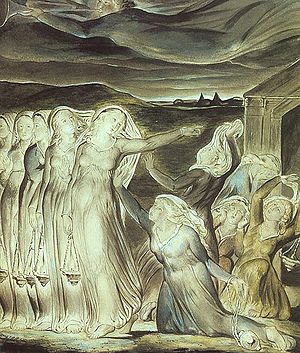 In the Olivet Discourse in Matthew 25:1-13, Jesus gives the Parable of the Ten Virgins which highlights the necessity for those people alive during the tribulation to be ready for the Second Coming of Christ. Certainly there would be the same need to be ready before the rapture of the church in a pretrib scheme, although that is not the focus of this chapter in my judgment. One of the interesting questions is whether the Ten Virgins represent Israel. This is argued in the Bible Knowledge Commentary. To be sure, Jesus speaks to the apostles in the Olivet Discourse as representatives of a future generation of Jews (those in the tribulation period) – note the symmetry provided by the end of Matthew 23 which points back and Matthew 24-25 which points forward. Furthermore, we know that Matthew’s Gospel is the most Jewish of the Gospels and deals with Jewish interests more than other Gospel authors. In addition, the Jewish custom of marriage feasts is highlighted in the parable. The groom picks up his bride and takes her to his house for a wedding feast where there will be many guests. This marriage feast represents God’s coming kingdom when Jesus returns. Not all will be ready. Five virgins make it in to the feast (kingdom) but five do not.
In the Olivet Discourse in Matthew 25:1-13, Jesus gives the Parable of the Ten Virgins which highlights the necessity for those people alive during the tribulation to be ready for the Second Coming of Christ. Certainly there would be the same need to be ready before the rapture of the church in a pretrib scheme, although that is not the focus of this chapter in my judgment. One of the interesting questions is whether the Ten Virgins represent Israel. This is argued in the Bible Knowledge Commentary. To be sure, Jesus speaks to the apostles in the Olivet Discourse as representatives of a future generation of Jews (those in the tribulation period) – note the symmetry provided by the end of Matthew 23 which points back and Matthew 24-25 which points forward. Furthermore, we know that Matthew’s Gospel is the most Jewish of the Gospels and deals with Jewish interests more than other Gospel authors. In addition, the Jewish custom of marriage feasts is highlighted in the parable. The groom picks up his bride and takes her to his house for a wedding feast where there will be many guests. This marriage feast represents God’s coming kingdom when Jesus returns. Not all will be ready. Five virgins make it in to the feast (kingdom) but five do not.
However, in spite of these seemingly good reasons, it is probably best not to see Israel represented in a symbolic way by the Ten Virgins. Instead, what Jesus is saying is probably simpler. He is basically using a cultural illustration that reminds the hearers and readers that not all will be ready for the Second Coming and the kingdom. More than Jews should be in view. We know from elsewhere in Scripture that many Gentiles will come to Christ during the tribulation (see the 5th seal in Rev. 6) and that the time of bitter distress will come upon the whole world and not just Israel (see Isa. 13:11, Rev 3:10, etc.). The judgment of the nations that follows later in Matthew 25 certainly involves Israel but highlights the judgment of Gentiles. In this light it is best to see Jesus warning all people of all ethnic groups to be ready for His coming.
This approach is similar to how the fig tree should be taken earlier in Matthew 24:32-34. The fig tree does not stand for Israel in a symbolic way. It is a simple and natural illustration. When one sees the fig tree budding, he knows summer is near. In the same way, when the generation in the tribulation sees the things happening there which Jesus has spoken of, they know that His coming is near. The kingdom is just around the corner.
The Olivet Discourse up to this point does not help the reader to know exactly how an individual is qualified to enter the kingdom – that is to be ready when Jesus comes. In the section on the sheep and goats, the passage comes closest to telling us but there is no clear expression like there is in Paul’s answer – “believe on the Lord Jesus Christ” — to the jailer’s question, “What must I do to be saved?” (Acts 16) One enters the kingdom by grace alone through faith alone in Christ alone (Eph. 2:8-9). We know from the Parable of the Talents, which occurs right after the Parable of the Virgins, that believers will be rewarded differently in God’s coming kingdom based upon how well they live their lives now. But the fact that they have a place in the coming kingdom is guaranteed by simple faith in Christ’s work to take away sin. There will be no braggers in God’s coming kingdom – no one who thinks he deserves to have a home in God’s kingdom will actually make it. He is not ready because he is depending upon his own good deeds instead of upon Christ.
The portrait is by William Blake (1822) supplied by Tate Gallery.
